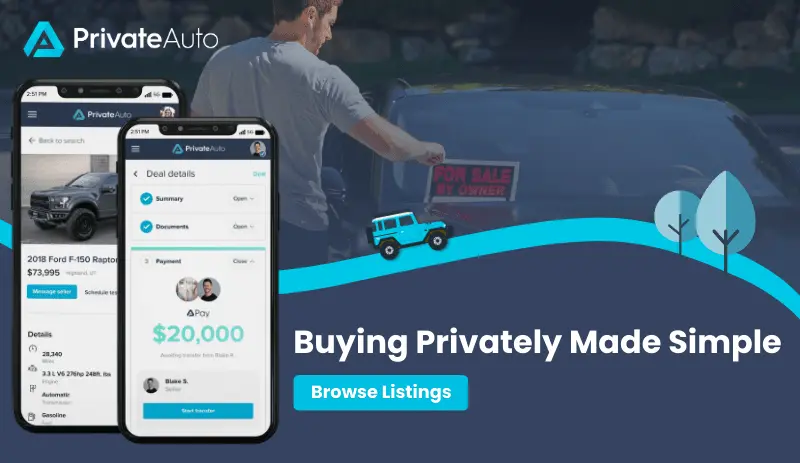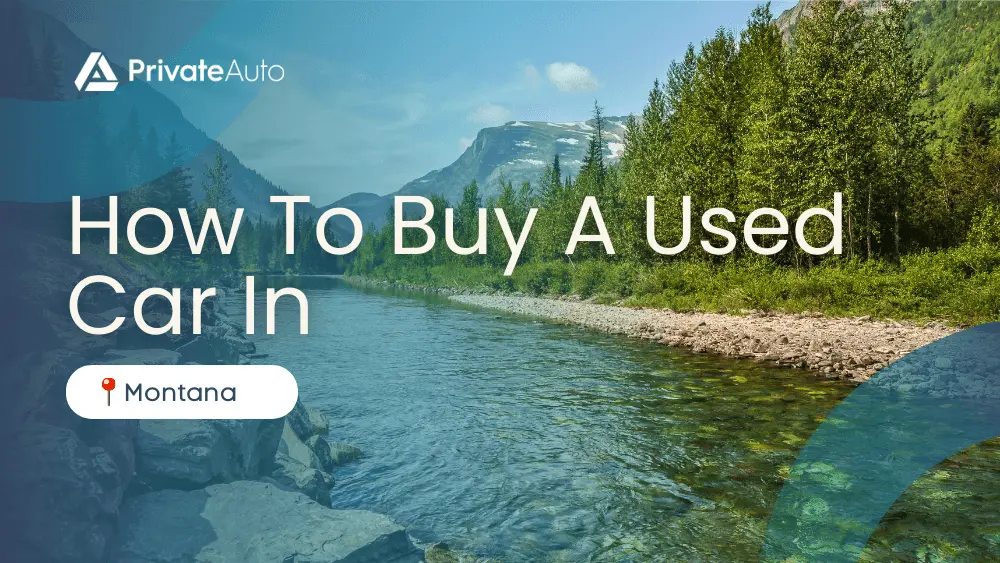Find a car
Step 1: Browse Used Vehicles Online
- Online classifieds
- National classifieds such as Craigslist and OfferUp.
- Local classifieds such as KSL Cars.
- Vehicle listing sites such as Autotrader.
- Social media listings.
- Auction websites such as Cars and Bids and Hemmings.
While these platforms help you find used cars near you, all of them lack transactional capabilities. They leave you to your own devices when it comes down to closing the deal, so we like to call them “meetingplaces”.
Another downside to most of these websites is that they mix dealer inventory with private-party cars. Most of them don’t have a simple way to filter by private-party vehicles, so you’re left digging through hundreds of dealer listings to find the private offerings.
We’re the world’s only fully self-service tech-enabled solution for every stage of the deal.
We have nothing against other listing sites. If you find your car on one of them, we’re happy for you. But we still want you to have the transactional security and convenience that our users enjoy.
That’s why DealNow was developed. It allows you to start a deal on any site, and close the sale anytime.
Invite the seller to DealNow and fast-track your transaction.

Agree on a price
Step 2: Negotiate a Price
On other sites, you’d have to message the seller and have an awkward conversation. PrivateAuto lets you make an offer with the click of a button. The seller can then accept, reject, or counteroffer.
Step 3: Vehicle Research
We have partnered with AutoCheck to provide vehicle history reports on premium listings. AutoCheck gets its data from the following sources:
- Collision repair shops.
- Service records from maintenance facilities.
- OEM manufacturers.
- Salvage auctions.
- Car dealerships and extended warranty companies.
- Auto auctions.
- State Departments of Motor Vehicles (MVDs).
- Insurance companies.
- Vehicle inspection and state inspection stations.
- Import and export companies.
- Rental and fleet companies.
Doing an AutoCheck on a vehicle uncovers valuable insights into the car’s background.
- Regular maintenance (or lack thereof).
- Title history: flood damage, salvage titles, junk titles, hail damage, storm damage, fire damage, and more.
- Lien information, ownership transfers.
- Manufacturer buybacks or lemon titles.
- Collision repair history.
- City and state of previous registration, number of owners.
- Accidents and damage reports, stolen vehicles.
- Rental, taxi, lease, or government use.
- Emissions records.
- Odometer rollback.
- Structural or frame damage.
- Service, repair, and maintenance performed.
- Total loss and reason for the loss.
- Stolen cars.
- Major repairs.
- Open recalls.
- And lots more…
Take the car for a test drive
Step 4: Take the Car for a Spin
Your privacy is compromised, and you waste a lot of time.
We keep your personal info secure. All communication happens through our secure messaging system. The in-app scheduler makes it easy to schedule the meetup: just select from the seller’s available times and show up at their designated location.
Step 5: Vehicle Inspection
Here are some of the things the Lemon Squad inspector will look into. Or, if you choose to do your own inspection, look out for the following:
- Body: check for obvious damage, body panel alignment, uneven gaps, mismatched paint, and signs of damage repair. Look closely for any indications of collision repair. Check for rust underneath and around various body panels. Check headlights, brake lights, and other lights.
- Fluids: check all fluid levels, including engine oil, transmission fluid, brake fluid, power steering fluid, and coolant. Look for leaks and make sure the fluids look clean and at proper levels.
- Undercarriage: inspect under the car for leaks, rust, and damage. Look at brake lines, exhaust, and suspension components.
- Tires: examine tire treads and make sure there is sufficient tread depth. Also look for any cracks, bulges, or other tire damage. Check the spare as well.
- Interior: ensure all controls, electronics, air conditioning, and heating work properly. Look for any warning lights on the dash when the car is started. Check for water damage, stains, or tears inside.
- Test drive: drive the car under different conditions to test acceleration, braking, steering, and transmission, and to feel and listen for any mechanical issues.
- Maintenance records: review the vehicle history report and check maintenance logs to understand repair and ownership history.
Handle paperwork
Step 6: Sign the Montana Bill of Sale
Here are the necessary elements included in a bill of sale:
- Date of the transaction.
- Price of the car.
- Your full name and signature.
- The make, model, and year of the car.
- The other party’s full name and signature.
- A warranty disclaimer stating the car is being sold as-is.
PrivateAuto provides an official Montana bill of sale as part of our standard in-app transaction process. At the appropriate stage of the transaction workflow, you and the seller will sign the Montana bill of sale electronically in the PrivateAuto app. You’ll each retain a signed copy in your PrivateAuto account.
You can then feel comfortable paying for the car, knowing the seller is bound by an enforceable contract.
Pay the seller
Step 7: Pay for the Car
You can send unlimited funds to the seller with no transfer fees. Holidays, weekends, or nights—anytime. The seller will receive the money immediately. It’s convenient, secure, and most importantly, easy to use. Its instantaneous nature provides escrow-like safeguards for you to control the deal.
If you are not in a place where you can pay cash for your next car, you can apply for a used vehicle loan directly through our app. When your application is approved, your profile will show that you have verified funds, setting you apart from other buyers.
Our lending partner will pay the seller in full when you close the deal and send payment. You will make monthly car payments to the lender. It’s that simple.
Want to know how much your payments will be? Our handy car loan calculator will tell you.
Step 8: Sign the Official Title Certificate
Both parties need to fill out the title certificate thoroughly. The following info is required:
- Names
- Addresses
- Damage disclosure statement
- An odometer disclosure statement
- Vehicle identification number (VIN)
- Signature
Odometer Disclosure
You can always complete the Federal Odometer Disclosure Statement so your bases are covered.
Inspect the odometer to verify that the seller’s entry is correct. Keep in mind that sellers who tamper with a car’s odometer to obtain a false reading can face serious consequences.
The PrivateAuto app has a field for the odometer reading so that both the buyer and the seller can check the mileage before moving forward.
VIN Check
The PrivateAuto app has a field for the VIN, where both the buyer and seller can check it for accuracy. This helps to eliminate any errors (or the rare case of outright seller fraud).
Insure the car
Step 9: Get Auto Insurance
The PrivateAuto app makes it easy to compare rates and get car insurance.
Step 10: Finalize with Montana MVD
They will require the following:
- The vehicle title signed by the previous vehicle owner.
- Bill of sale (proof of ownership)
- Completed Application for Certificate of Title for a Motor Vehicle
- Proof of auto insurance.
- Payment for the title transfer fee: $10.30.
- Payment for the passenger vehicle registration fee: from $28 to $217.
- Payment for Montana license plates: $12.36.
- Potentially other taxes and fees, depending on your city and county of residence.
- Valid driver’s license.
For more info about the title transfer process, read our Montana title transfer guide.
Montana License Plates

Transfer ownership
Register the car
Get new license plates
Should I Buy from a Dealership or a Private Seller?
The private-party purchase offers the following advantages:
1. You drive the deal on your terms. PrivateAuto allows you to make offers and negotiate the best deal directly with the seller.
2. Get a better price by cutting out the middleman and going straight to the source. Dealers must buy low and sell high to make a profit and keep the lights on.
3. Avoid fees. Vehicle dealers charge documentation fees that range from $50 to over $1,000.
Before PrivateAuto, dealers offered an escape from the messiness of the private-party sale. People were willing to pay fees and markups for that convenience. Now they don’t need to. We bring security and dealer-like convenience to the private-party car transaction
Our transactional marketplace gives you all the tools to drive the deal on your terms, including unlimited instant payments with no transfer fees.
Montana FAQ
Does Montana have vehicle sales tax?
The Treasure State lets you off the hook for sales tax, but you still need to pay the fees involved with registering and titling the car.
Is auto insurance mandatory in Montana?
When it comes to driving in Montana, auto insurance is not just a good idea; it’s the law. The state requires drivers to have valid and sufficient insurance coverage to protect themselves and others in the event of a car accident.
Insurance premiums in Montana can vary depending on several factors, including your driving history, age, and the type of vehicle you own. If you are involved in a car accident, having insurance coverage can help cover medical expenses, property damage, and other costs associated with the accident.
Here is the minimal insurance cost every vehicle owner must have:
– Bodily injury: $25,000 per person
– Per accident: $50,000
– Property damage: $20,000 per accident
– Uninsured or underinsured motorist: $25,000 per person and $50,000 per accident
Why do Uthans register vehicles in Montana?
There are several reasons why Utah residents might choose to register their vehicles in Montana and save thousands of dollars.
1. Favorable registration fees: compared to Utah, Montana may have lower registration fees or different fee structures. Individuals who register their vehicles in Montana may be able to benefit from potentially lower registration costs.
2. No sales tax: because Montana does not have a general sales tax, individuals who register their vehicles there may avoid paying sales tax on the purchase. This can result in cost savings, especially for high-priced vehicles.
3. Privacy and confidentiality: because Montana allows the use of a registered agent for vehicle registration, some individuals may register their vehicles in Montana to maintain privacy and confidentiality. This means that personal information associated with the vehicle may not be available to the general public.
4. No emissions requirements: Montana does not have a mandatory emissions testing program for vehicles. Individuals with vehicles that may not meet Utah’s emissions requirements opt to register their vehicles in Montana to avoid such testing.
While Utahns save thousands of dollars by doing this, intentionally registering a vehicle in another state to avoid sales tax or fees is not legal. Vehicle registration should take place in the state where the vehicle is primarily used and where the owner resides.
While avoiding sales tax by registering your vehicle in another state is illegal, the details of your situation matter. Talk to an attorney to decide if registering your vehicle in Montana is right for you.
Helpful Resources
Popular Cars For Sale

Caleb Whittle
Contributing Author
Caleb Whittle is the Chief Marketing Officer at PrivateAuto. He’s based in Utah and has had a passion for education and learning throughout his life. Helping others understand the nuances of buying & selling cars has become his mission through content creation and writing. His current dream car is a Tesla Model S Plaid.
